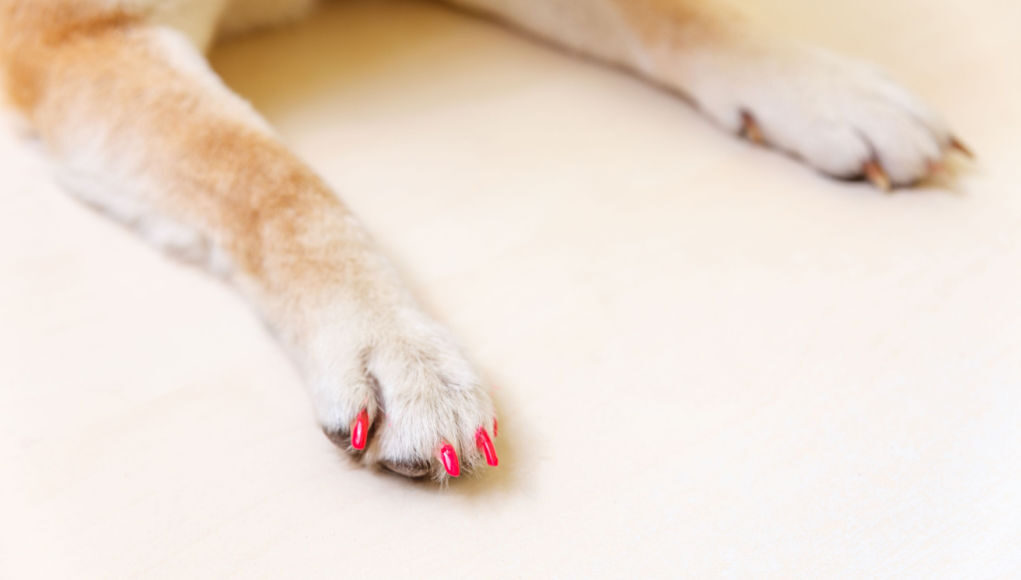Table of Contents
- Human Nail Polish on Dogs: Is It Safe?
- Is Nail Polish Bad for Dogs to Smell?
- Symptoms of Nail Polish Poisoning in Dogs
- What To Do if Your Dog Ingest Human Nail Polish
- How to Safely Remove Polish
- Doggie Nail Polish: A Safer Alternative to Human Nail Polish
- How to Apply Dog Nail Polish
- Human Nail Polish on Dogs: Final Thoughts
No doubt that dogs are naturally cute and lovable creatures, no matter their breed. That is why many fur parents want their pets to look their best.
Some of us are even guilty of splurging on the latest trends in dog dresses and accessories so that we can brag about our pets on our social media pages.
Others may go even as far as painting human nail polish on dogs.
While basic grooming is crucial, the trend of dog pampering is a bit more complicated. Like our fashion trends, quirky canine style can quickly change!
This month it is bucket hats and dapper neckties. A few months after, it is bandanas and pet-safe hair dye.
Some dog grooming salons even offer canine manicure services to give your dog’s nails a pop of color. This trend gives Fido a unique look or matches its nail colors with your own.
Knowing that most human products are unsafe for animals, we wonder, “Can I paint my dog's nails with human nail polish?”
Related: How to Groom a Dog: All-in-One Guide for Beginners
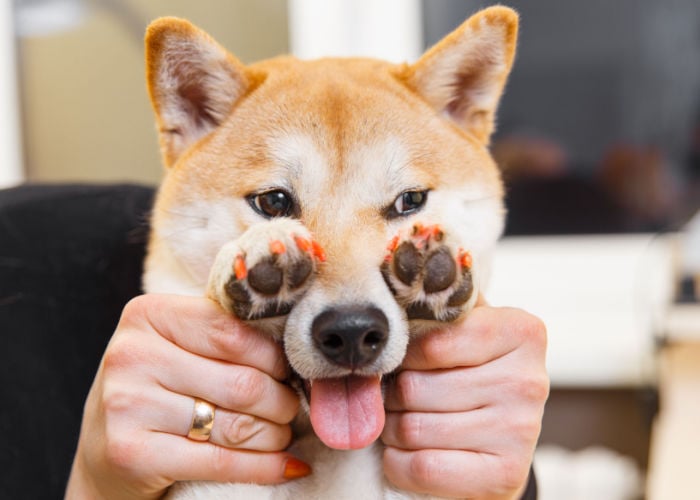
Human Nail Polish on Dogs: Is It Safe?
Regular grooming is essential for your pet’s health and well-being, but using human nail polish on dogs is a no-no.
Sometimes, our desire to make our pets look good can risk their health or even lives. So before you start painting your dog’s nails, how is nail polish toxic to dogs?
The nail polish we use to decorate our nails contains ingredients that are toxic to animals, especially our dogs.
Standard nail polish is safe for humans since we do not ingest them. Dogs, on the other hand, do not have that instinct.
Always check the list of components used in your favorite shade of nail lacquer for toxic additives.
Below are the harmful components that cause nail polish poisoning in dogs. These ingredients should be avoided at all cost:
Toluene
This clear, colorless liquid chemical can quickly evaporate when exposed to air at room temperature, producing a sharp or sweet odor.
Nail polish products use toluene to keep them smooth.
Several studies claim that toluene inhalation can cause dizziness, headaches, eye irritation, and nausea.
This hydrocarbon can also put our pets at risk of poisoning just by inhaling its pungent odor.
If consumed in large amounts, our pets will show symptoms such as vomiting and severe neurologic damage.
Formaldehyde
Used to harden the polish on the nails, formaldehyde is a harmful chemical substance and a known carcinogen that has been associated with lung and nasal cancers.
Studies show that formaldehyde can irritate lab animals' eyes and upper respiratory tract.
When ingested, it can result in severe erosion of gastrointestinal tissues. Since formaldehyde is a known skin irritant, repeated contact can lead to allergic skin sensitization.
Dibutyl Phthalate
Also called DBP, this substance keeps nail polish more flexible and prevents it from cracking and chipping.
Phthalates have been reported to cause various health problems. Animal studies claim that phthalate exposure can adversely affect the liver, kidney, and male and female reproductive systems.
Heavy ingestion of this chemical causes your dog to retch, gag, and drool profusely.
Is Nail Polish Bad for Dogs to Smell?
Human nail polish contains chemicals that can trigger nasal irritation, causing him to sneeze and other adverse reactions.
Since dogs have a hypersensitive sense of smell, they can pick scents more strongly than we do.
That is why you should avoid painting your nails near your dog or do their nails with human nail polish.
Related: Study: How Dogs Developed Such Good Sense of Smell
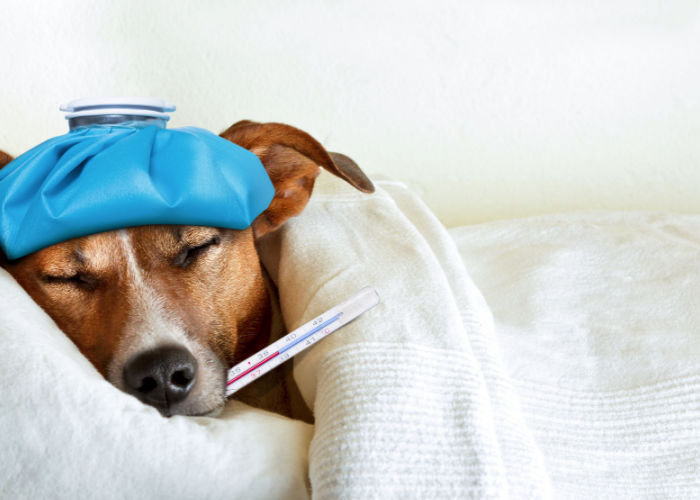
Symptoms of Nail Polish Poisoning in Dogs
The symptoms of dog poisoning usually depend on how much nail polish your pet ingests.
When consumed, nail polish can irritate your dog’s digestive tract, causing gastrointestinal symptoms like vomiting, abdominal pain, and diarrhea.
An upset stomach can also result in excessive drooling. Other signs to look out for include:
- Lethargy
- Loss of appetite
- Tiredness
- Fatigue
- Seizures
- Tremors
- Difficulty breathing
Some symptoms typically appear within a few hours after ingestion, but others will surface within 1 to 2 days.
While nail polish poisoning is rarely severe, it can be potentially fatal, so you must closely monitor your pet.
If your pup starts to show poisoning symptoms, take him to the nearest vet clinic for immediate and proper treatment.
What To Do if Your Dog Ingest Human Nail Polish
Finding out that your four-legged pal has ingested nail polish can be downright terrifying. It is best to stay calm and keep a clear mind at times like this.
Check the bottle to see the amount of nail polish your pet has consumed.
Be vigilant and watch out for signs that your fur baby is unwell (refer to the symptoms above).
When your pet starts to show signs of feeling sick, call or bring him to the vet immediately. Never induce vomiting unless instructed by the vet.
Here are some helpful tips on what you need to do (and not to do) if your pup accidentally ate nail polish:
What To Do
1. Call or Visit Your Trusted Veterinarian
Ingesting a small amount of nail polish may not result in any severe toxicity on your dog.
Even if your pup appears normal after ingestion, it is still advisable to contact or visit a veterinarian for professional medical advice to ensure the health and well-being of your pet.
Do not forget to take the bottle of nail polish ingested by your dog.
The sooner your pet receives proper medical treatment, the higher his chances of recovery.
2. Keep a Watchful Eye on Your Dog
Secure your dog immediately to ensure he does not ingest any more nail polish. Inspect the bottle and keep it away from your pet.
If you have other pets, take them to a separate area in your home to prevent any contact with your dog. This enables you to pay attention to your pet.
3. Give Your Dog a Bath
If your dog has nail polish on his fur, the chemicals can get absorbed through the skin.
Be sure to bathe them to remove the nail polish from the skin and coat.
4. Do Not Panic
Feeling anxious is a normal reaction when your pet has consumed something harmful.
Despite the outcome's uncertainty, staying calm and taking control of the situation is still best.
Call your primary vet, observe your dog, and calmly follow any further instructions.
What Not To Do
1. Do Not Induce Vomiting
While it may seem logical, it is advisable never to induce your dog to vomit.
When the vomit backs up, the chemicals in nail polish can only cause caustic injury to the esophagus.
Always ask for advice from the vet before taking any action.
It is crucial to keep in mind that if the symptoms of poisoning have already surfaced, it will be too late to induce vomiting.
2. Refrain from Home Remedies
Never try any home remedies without veterinarian instruction. For instance, giving milk or peanut butter may only worsen your dog's condition.
While you can find plenty of home remedy tips online, go to the nearest vet for proper treatment to ensure the safety and health of your pup.
Related: 6 Cleaning Products That May Be Poisoning Your Dog
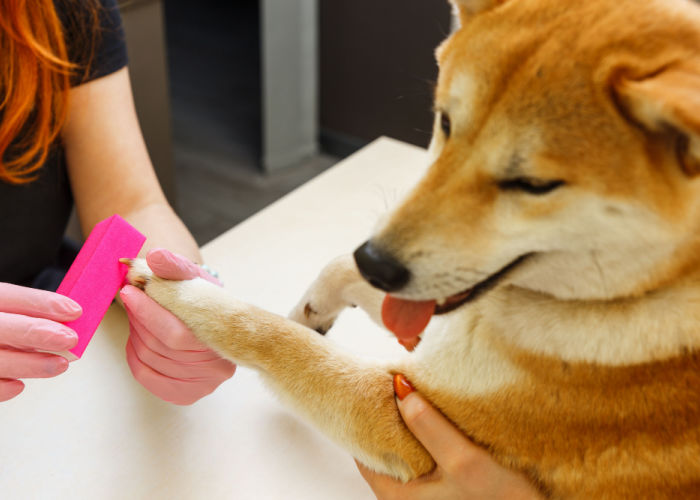
How to Safely Remove Polish
Acetone in polish remover is also a harmful chemical that can cause burns to the mucus membranes, mouths, and esophagus.
When ingested in large amounts, it can lead to poisoning that can cause an upset stomach, excessive drooling, loss of appetite, seizures, and lethargy.
If your pet experiences these symptoms, take them to a vet for immediate treatment.
Here are some tips to safely remove nail polish from your pet:
- Soak your dog’s nails in a mixture of lemon juice and white vinegar for several minutes and wipe them clean.
- Use a nail file to sand away the polish.
- Wipe it with a soy-based dog’s nail polish remover. Apply a small amount of shampoo on a soft brush or sponge to remove the remnants.
Doggie Nail Polish: A Safer Alternative to Human Nail Polish
If you want to give your dog a bit of glitz and glamor, you can use a dog-safe nail polish, which can be bought in pet shops.
Professional groomers use dog-safe nail polishes to give your dog’s nails a beautiful color. Nail polishes formulated for canine use do not have any toxic chemicals found in human products.
Also, it contains healthy ingredients, such as aloe vera and vitamin E, to ensure safety.
Since doggie nail polish does not contain toxic chemicals, it does not emit a harsh lacquer smell. However, use dog nail polishes in well-ventilated areas to prevent distress from your pet.
A doggie nail polish dries more quickly than its human counterpart to give dogs a quick and comfortable experience.
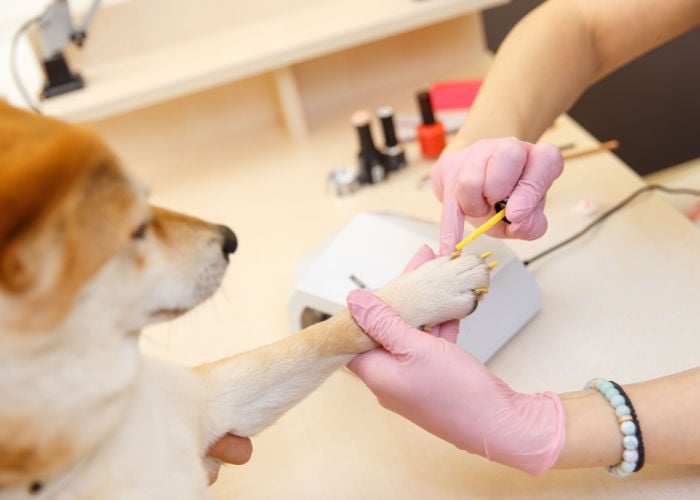
How to Apply Dog Nail Polish
Dog-formulated nail polish is a growing trend that has attracted many fur parents.
However, as pet owners, it is vital to keep your pup safe while glamming up their paws.
They come in various vibrant colors to match your pet's personality. You can even explore creativity by combining colors to create beautiful nail art.
Dog nail polishes come in traditional bottles and pen form. Dog pen nail polishes are ideal for artistic fur parents who want to give their pup’s nails stylistic designs.
Also, its fine pen tips enable efficient distribution of polish and give you control to create some artistic styles.
- Before you purchase dog nail polish, be sure it uses safe ingredients for your dog’s health. Check the condition of your dog’s nails before applying the product. If unsure, ask the groomer or vet for help.
- If their nail is in good condition, clip the dog’s nails first but do not cut them too short to avoid hurting your pet.
- Also, trim the fur surrounding the paws and nails of your dog, as the nail polish can stick to the fur, messing up the design.
- Dogs dislike having their paws touched. However, giving them rewards or treats can help change their attitude, allowing you to touch their paws.
- Apply the nail polish once your dog is relaxed.
- Leave the polish to dry for a few minutes before allowing your dog to return to its normal activities.
Additional Tips:
For dogs with black-colored nails, you may require a base coat as a primer to cover up the natural nail color and give you a blank canvas for color.
You can also buy a top coat polish to give your dog’s nails a specific finish and protect them from chips and damage.
Related: How To Trim Dog Nails Without Clipping the Quick
Human Nail Polish on Dogs: Final Thoughts
Never use human nail polish on dogs to avoid potential poisoning.
When your pet chews on his painted nails or consumes nail polish, he could ingest harmful substances that can cause minor or severe health issues.
To keep your pets safe, be sure to store human nail polishes and removers away from them.
Dogs are curious creatures who will try to explore just about anything with their noses and taste anything that captures their attention.
Nonetheless, if your pet has eaten or been exposed to toxic stuff, do not hesitate to contact your trusted veterinarian and seek medical assistance for nail polish poisoning treatment.
When push comes to shove, you can take your pet to a doggie salon that offers dog nail polish services as part of their grooming packages.
With expert skills, your dog will have fabulous nails after their day at the spa!
Do you have experience painting your dog’s nails or any recommendations for the best nail polish brands for dogs?
Share your thoughts with us in the comment section.


